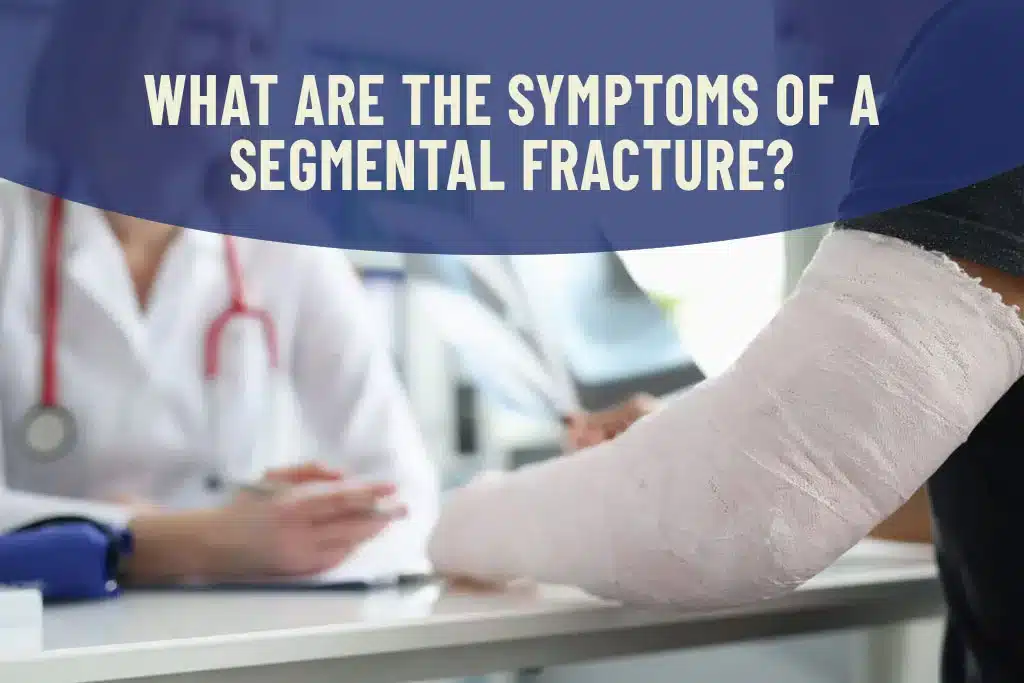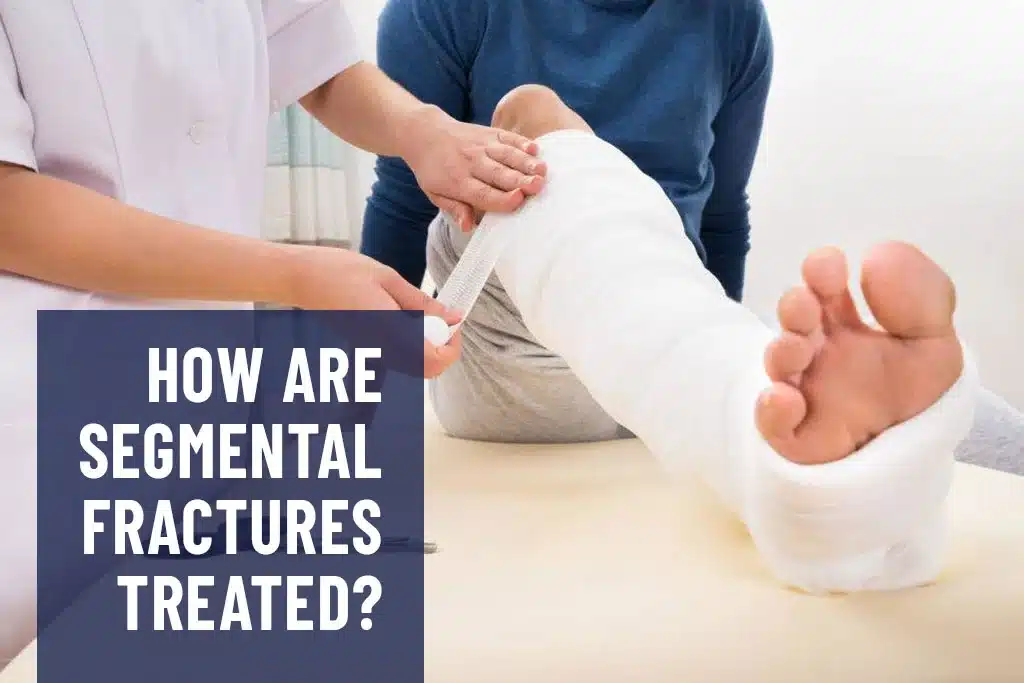Are you dealing with the painful break of segmental fracture and need to know its specifics? Explore our in-depth guide that addresses almost all of your concerns. This in-depth guide explains the complexity of segmental fractures. We’ll go beyond the fundamental break to investigate the reasons for this double-whammy injury. From high-impact events to underlying disorders, we’ll look at the variables that can cause a segmental fracture. At the ER of Watauga, we offer specialized care and a comprehensive range of solutions for segmental fractures.
We will assist you in the healing process and offer advice to help you recover and regain strength and functionality after a segmental sign fracture. So, if you feel like you’ve got more than just a simple break, and the bone is cracked, you are in the right place, as this instruction is for you. Through assessing inter-group cracks, we educate patients to base their health decision-making on the solid serving of truth and full recovery.
What is a segmental fracture?
Segmental fractures are a particular type of break that occurs when the bone is fractured into two locations, other than the break of the bone, creating a distinct segment of the bone. Not all the cracks are of the same shape and size, this can take place in any long bone of your body.. Some of the most common include:
- Femur (thigh)
- Tibia (shin)
- Fibula (calf)
- Humerus (upper arm)
- Radius and ulna (forearm)
- Clavicle (collarbone)
Therefore, it is quite obvious that fractures in the form of segmental ones are almost always a result of very serious accidents like car crashes or skyfalls. They could be life-threatening, so you might need to go through a surgical procedure to be able to fix your bones. How long it takes depends on which of your bones are broken – and what was the cause. It is worth mentioning that the recovery period differs a lot for the different types of bone breaks. Most of the individuals aiming at a quick recovery should count up at least a year of rest from a segmental fracture.
comminuted fractures vs. Segmental fractures
Shared and disseminated bone fractures alike are very severe classifications of bone fractures. Those are different words that communicate detailed information about the bone fracture, the way it is broken, and in what area of your body and internal body. Those help the healthcare providers in identifying your health condition right away.
Segment fractures are basically two different cracks in your bones; a section of your bone has been separated from the other one because of the break. In comminuted fracture cases where your bone is broken into three or more parts, mobility becomes an issue. These kinds of splintered fractures can be comminuted. Contrarily, some of these as well as all may not be.
Whether it is a sprain, strain, or whatever, a name that provides to your fracture, the crucial primary step is to get your injury examined by an appropriate healthcare provider as soon as possible.
How does a segmental fracture occur?
A person of any age group may be vulnerable to fractures in their long bones (“segmentary bone breaks” is a different term for any kind of fracture). This is highly probable as they are created because in most cases very traumatic events. Having the brunt of it, someone would always get into an accident and suffer a broken bone of some kind, without any way to predict whether and how soon.
Symptoms and Causes
What are the symptoms of a segmental fracture?

If you broadly fall into one of the fracture categories such as segmental, you may find yourself experiencing a big range of symptoms of the event that caused it. Which of your symptoms depends on the other hurt sides you have. But in general, the symptoms of a segmental fracture can include: But in general, the symptoms of a segmental fracture can include:
- Intense pain
- The physically bounding sensation of not being able to move a specific part of your body than you have been previously able to
- The normal pattern of your body is broken into two parts because of a remarkable or out-of-place appearance
- Waking up to the sight of the rib bones protruding through the skin
- Swelling
- Bruising
Open vs. closed fractures
The health care specialist will categorize two types of fractures that might have happened from either open or closed. If your open fracture is a kind of broken bone with bone exposed through the damaged skin layer, then consider it the worst of a complex. A compound fracture, where the bone is exposed, is a much more complicated type and much harder to heal than an open one and is more likely to lead to complications such as infections and secondary nonunion. History is on your side, you see because with a closed fracture, your bone doesn’t protrude from your skin.
What causes segmental fractures?
Among the many accidents that oddly occur on a daily basis are bumping into a vehicle and falling from heights, either it could be off a ladder or the rooftop.
Bones, even the thinnest ones, are high-strength materials. They can bear huge loads of stress and tension. However, any deleterious effect on them may compromise their integrity and lead to a fracture. Nevertheless, arm, leg, and ankle fractures from slip-and-falls and various other common injuries won’t be powerful enough to damage your bones and cause this type of fracture.
How are segmental fractures diagnosed?
Your general practitioner will diagnose a fracture of a segment using a physical exam and some tests like X-rays. Sometimes, it will take place in your ER immediately if you want to be taken there after the trauma.
However, if you’re transported to the nearest ER, a crew of healthcare practitioners make the patient stable and treat his injuries according to their degree of severity, with priority given to those that may be life-threatening. Then, your recovery starts when you stabilize yourself in a wheelchair or bed. For sure, you will need imaging tests to prove your broken bone.
What tests are done to diagnose a segmental fracture?
You’ll need at least one of a few imaging tests to take pictures of your fracture:
- X-rays: an x-ray will certify any segmental or other fractures and help to assess how escaped your bones are.
- Magnetic resonance imaging (MRI): Your doctor could possibly use MRI as a show of the injury done to your bones and the area located close to them. This will demonstrate to them the structure and complex bone arrangement around their bodies, as well. It is critical at this point to check on your muscles, tendons, and organs’ injury situation because the injuries might have affected them.
- CT scan: The whole process of CT scanning provides your healthcare provider or surgeon with in-depth knowledge of the bones and adjacent tissues in ways that traditional X-ray examination cannot.
How are segmental fractures treated?

With segmental fractures, the vast majority of cases are dealt with surgically. Stabilization and cauterization are common techniques used to correct a broken bone, but the approach that your surgeon will use depends on your specific case.
A surgeon will rearrange (position) your bones properly and then put them in their right place so that the healing process can begin. In most cases, the physicians use internal fixation which implies that your surgeon places pieces of metal (known as bone screws or plates) into your bone to keep it fixed while it heals. Internal fixation techniques include:
- Rods: The part is positioned in the middle of your thigh and runs through the upper to the lower part of your thigh.
- Plates and screws: Trembling is the side-effect of painkillers. They prevent you from feeling pain. Instead, they develop drowsiness, slobbering, or bad mood.
- Pins and wires: Through the use of screws and wires, smaller pieces of bone can be fastened together since they may not require larger equivalents. This is to make it possible for either rods or plates to be used at the same time.
While some people with these inserted pieces will always be around, others will discard them more often. You could require other surgeries apart from this one to take them out.
External fixation
This is an ephemeral action that hospices your fracture while you are healing from other injuries. To put the screws on either side of your fracture inside your body, your surgeon will have to connect them with a brace or bracket to be wrapped around the outside of your given bone.
Sometimes visiting surgeons rely upon outside pin procedures temporarily while waiting for more invasive treatments to heal their segmental fractures. For starters, all the injuries can lead to low strength, which in turn lasts longer to recover so that you can withstand the operation of internal fixation. Your doctor might elect to apply the fixator device internally as they wait for your body’s swelling to go down.
Without a need for hospitalization, segmental fracture surgeries are usually day surgeries, which means you can be discharged immediately continuing your recovery at home. On the other hand, it’s possible that the trauma was also a factor in the injury that caused your segmental fracture which will be a reason for you to need hospitalization while on the road to recovery.
After you have the surgery on your fractured bone, you will be hospitalized and the part of your body which entails that is fractured will be immobilized. This will depend on where the incident took place, and it demands a definite combination of a brace, splint, or cast to allow you to start to put any weight on it or to use it as you once did before.
What medications are used to treat segmental fractures?
Long-term intake of non-prescription NSAIDs such as Aspirin or Ibuprofen may result in bleeding and other serious complications after operation. The medications that your surgeon can prescribe for you, to deal with pain after your surgery, will also be covered in the talk.
Complications of Segmental Fracture Treatment

Segmental fracture surgery complications include:
- Acute compartment syndrome (ACS): Doubling of tension and pressure will be stopped from going to muscle and nerve tissues with the result of permanent damage and nerve damage.
- Malunion: This leads to your bones not lining up correctly in just the right way while they’re healing.
- Nonunion: The bone may be permanently damaged even if it is fixed to its old full structure.
- Bone infection (osteomyelitis): If you suffer a compound fracture and have a bone that perforates the skin, there is a higher chance of bacteria contaminating and infecting your wounds.
- Other internal damage: A recent injury can often negatively affect the tissues around your hurting spot, such as your muscles, nerves, blood vessels, tendons, and ligaments.
Side effects of NSAIDs include:
- Bleeding
- Ulcers
- Stomach pain
- Bowel complications
How soon after treatment will I feel better?
By the end of this therapy, it would take you another few weeks to recover and get well. There is a course of recovery when it comes to types of surgery to fix your broken segments such as where it was or which bones were injured. This recovery period may take two weeks on average.
Should your pain continue to be severe and not resolve you will need to get an expert opinion from your doctor. Write down 2 topics that are of your interest, and 2 topics that make you think about/care about.
Prevention
How can I reduce my risk for segmental fractures?
Follow these steps to reduce your risk of injury throughout your daily routine:
- Always wear your seatbelt.
- Whether you’re playing or working, always don protective equipment for every activity and sport.
- Being free of accidents in the hall and room is all necessary for your home and working environment; nothing should just mess up your feet or others elsewhere.
- To avoid any danger, you must have the proper tools or equipment at your house which can help you to reach high things. Always avoid standing on the tables, chairs, and counters. Makeup Tips: A Step-by-Step Guide
- Set up a food and exercise regimen that would ensure your well-being.
- Go see your healthcare provider if you are more than 50 years old or if you possess a family history of osteoporosis.
How can I prevent a segmental fracture?
Since the accidents caused by segmental fractures may take place suddenly, they seldom may be avoided in full. You don’t know when a trauma can occur; thus, as long as one experiences a segmental fracture, it will not be of any assistance.
What can I expect if I have a segmental fracture?
If you have a stabilized fracture, the recovery will probably be longer than for members who are stripped of other types of broken bones. The healing process might take a year or even next year, depending on affirmation and other injuries.
As far as physiotherapy treatment is concerned, aimed at restoring strength and range of motion in the injured part of your body, this is what will be prescribed to you. This therapy will combine with your wider healing plan for other injuries.
How long does it take a segmental fracture to heal?
The serviced bone surfaces need time to grow together. They are the place of the slowest bone regeneration rate in the functional healing process. Consequently, the likelihood of having complications is also higher. you may work alongside other healthcare providers in an emergency room, a special hospital, or other relevant facilities.
Almost all cases of segmental fractures may take close to a year to heal. The duration for your bone to heal will depend on the brownness of the fracture as well as some complications that may show up.
When should I go to the emergency room?
If you’ve got a fracture in the local section, if it is any other bone fracture, you need to see a healthcare provider immediately. Go to the emergency room if you experience any of the following:
- Intense pain
- The part of your body, the movement of which is inadvertent, becomes immovable
- You are part of a body that displays a notable, altered look or that emerges from a location it would not normally be in
- The bones are under my skin and you can use a flashlight to see the shape
- Swelling
- Those that show up as well as any of the other mentioned symptoms at the same time
- Cease immediately and seek urgent medical attention if you’ve just been mishandled
Conclusion
A segmental fracture usually happens with an accident that may be serious and even fatal. The spookiest part is that with them you can’t plan retaliation. The bright side is that surgeries to reconstruct segmental osteoporosis usually reach up to 90 percent and a few more are successful only in exceptional cases. The process of getting back healthy after a major trauma may seem unreal, but consider that you don’t have to take one step at a time and from one point to another, and recognize your progress as you are going. ER of Watauga is your go-to urgent care facility offering individualized care for your health issues and ensuring peace of mind. Contact us now to book an appointment or to get further information.
FAQs
What causes segmental fractures?
Segmental fractures are among the most prevalent kinds of high-energy trauma such as car accidents, falls from heights that are beyond the range of gravity, or sports injuries.
How are segmental fractures diagnosed?
The diagnostic process usually commences whereby a physical examination, X-rays, and advanced imaging such as a CT scan performed to determine the condition and the distinct location of the fractured segments.
What are the treatment options for segmental fractures?
Surgery might become treatment and it will be to put the segments of bones into proper alignment and then to stabilize them with plates, screws, or rods. For some other situations, traction devices or external fixators will be used.
What is the recovery process for segmental fractures?
How long the healing period differs from patient to patient is based on the condition of the break and the treatment type that the patient has been provided. Strength regrowth and, moreover, range of motion in the impaired limb is also achieved through physical therapy. Such review sessions and imaging might be required to determine the stage of the healing regime.






